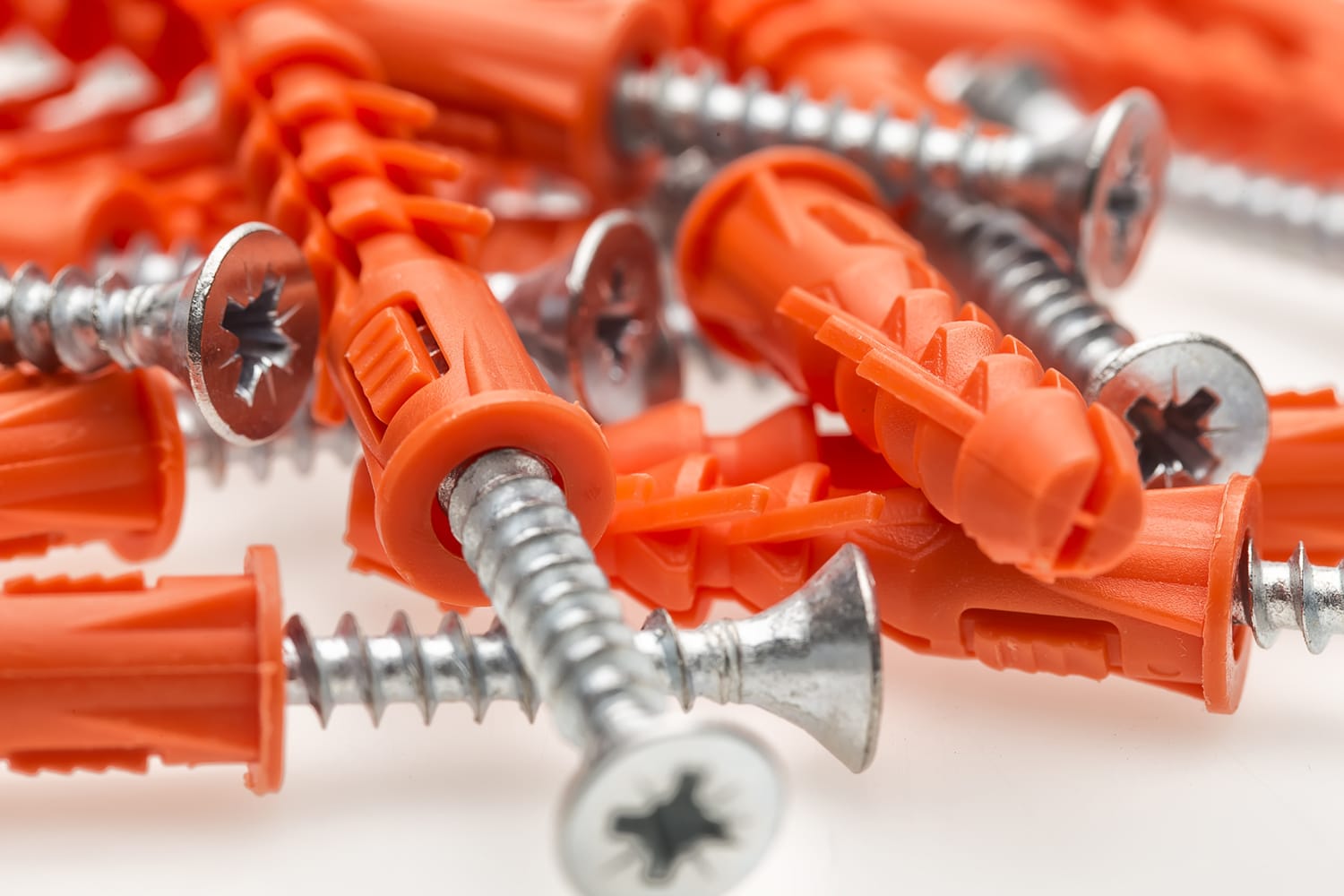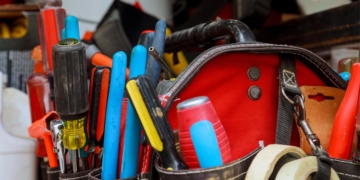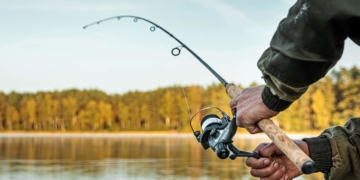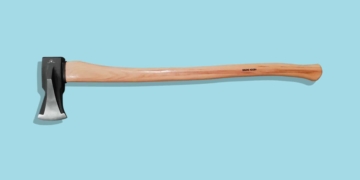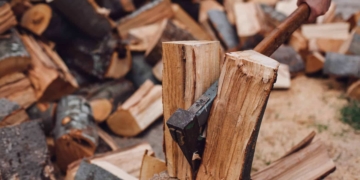OUR EDITORS INDEPENDENTLY RESEARCH, SELECT, AND RECOMMEND THE BEST PRODUCTS FOR REVIEW. AT TIMES (AND AT NO EXTRA COST TO YOU), WE MAY RECEIVE COMMISSIONS ON PURCHASES MADE THROUGH OUR CHOSEN LINKS. WE WILL ONLY EVER PROMOTE THE PRODUCTS AND SERVICES THAT WE TRUST AND 100% RECOMMEND. YOU MAY READ OUR FULL AFFILIATE DISCLOSURE POLICY FOR MORE INFORMATION.
Best Wall Anchors 2024 – Updated by Burbro Editors on April 14th, 2021
When you’re hanging items on your walls, it can cause problems if you have drywall in your home. This is because the drywall will crack under too much weight. After all, drywall isn’t intended to carry much weight. One of the solutions to this problem is using anchors. Wall anchors are small items that you can insert into the drywall so that you can hang heavier items on your walls by drilling your screws into a drywall anchor that has been inserted into the middle of your drywall walls.
Best Drywall Anchors of 2024
We’ve reviewed the best drywall anchors that you can use and compiled the top products into a list so that you can quickly find what you’re searching for. While we’ll review each of these products, the list will help you quickly find the products that you need for your project.
Here are the best drywall anchors of 2024.
- Best Self Drilling Drywall Anchors: Qualihome Self Drilling Anchors
- Best Sleeve Wall Anchors: LeanKing Plastic Drywall Anchors
- Best Expansion Wall Anchors: Swpeet Expansion Drywall Anchors
- Best Hollow Drive Wall Anchors: Glarks Hollow Drive Drywall Anchors
- Popular Self Drilling Wall Anchor: ISpinner Self Drying Drywall Anchors
1. Qualihome Self Drilling Anchors
The Best Self Drilling Drywall Anchors.
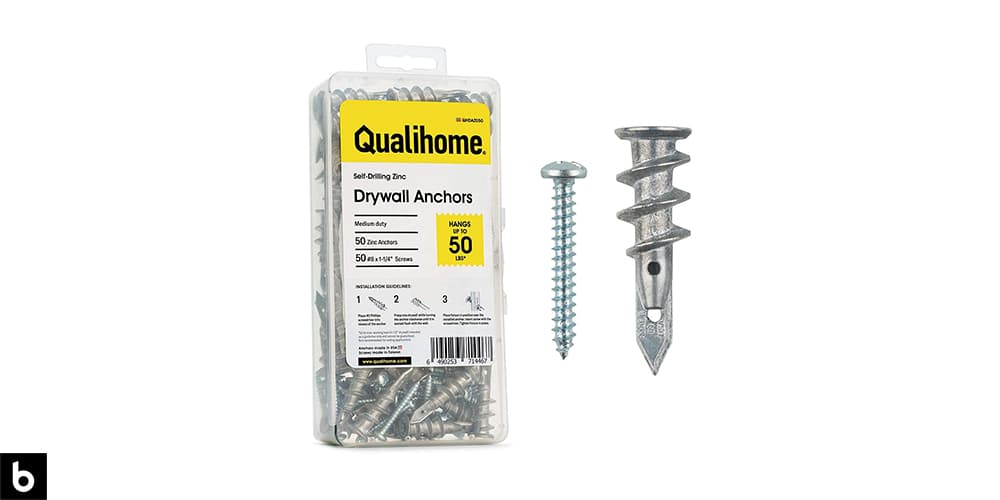
If you need to hang stuff on the walls, you may be interested in using a drywall anchor that’s ‘self-drilling.’ One of the best self-drilling anchors is the Qualihome Self Drilling Anchors. These anchors come with a deep thread design, which makes it easier for you to insert the anchors into the wall, and the threads will keep the anchor from coming out of the wall once you’ve hung something onto the anchor. The Qualihome self-drilling drywall anchors come with the right sized screws that are used to be inserted inside the anchors so that you won’t need to shop for screws. With these self-drilling anchors, you’ll be able to hang items up to 50 lbs in weight.
2. LeanKing Plastic Anchors
One of the Best Sleeve Wall Anchors.
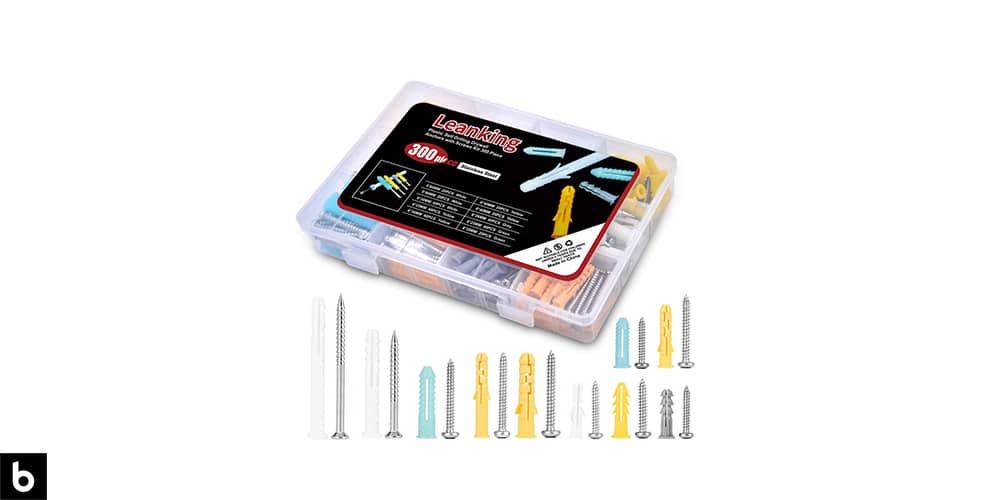
When you’re hanging lighter items like a mirror, wall art, or pictures, you may want to use the sleeve anchors to help hold the screws in the drywall. One of the best sleeve wall anchors is the LeanKing Plastic Anchors. These anchors come in a kit of 300 pieces with a variety of sleeve sizes so that you’ll have heavy-duty sleeves for screws of all sizes. When you’re using the right size sleeve for your screws, you’ll prevent the sleeve from breaking and becoming ineffective. The LeanKing Wall Anchor kit also comes with the right sized screws intended for the sleeves so that you’ll never have to go size the screws at the store. Instead, you can begin installing the items on your wall with this ready-to-go anchor kit.
3. Swpeet Expansion Anchors
The Best Expansion Wall Anchors.
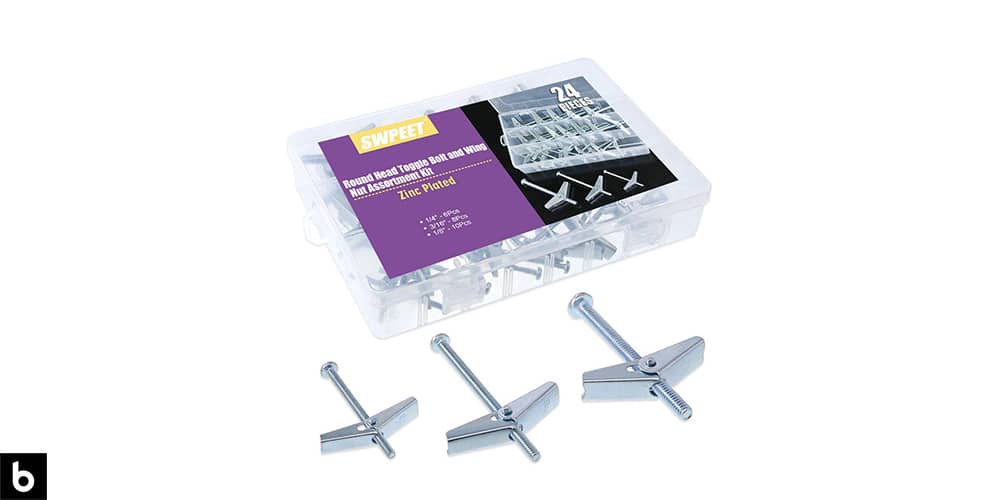
When you’re hanging heavier items, you may want to use expansion anchors because the expansion anchors spread their ‘wings’ and it’s able to hold more weight. One of the best expansion wall anchors that you can use is the Swpeet Expansion Drywall Anchor. The Swpeet Expansion Anchors use a toggle bolt design, which allows you to insert the wings into a smaller hole in the wall, and as you tighten the bolt, these wings will open up and grab the backside of the drywall. With the Swpeet Expansion Anchor Kit, you’ll have various toggle expansion bolts that you can use in your home. This will allow you to hang a variety of items in your home while ensuring that you have the right size of wall anchor for the items you’re trying to hang on your walls.
4. Glarks Hollow Drive Anchors
The Best Hollow Drive Wall Anchors.
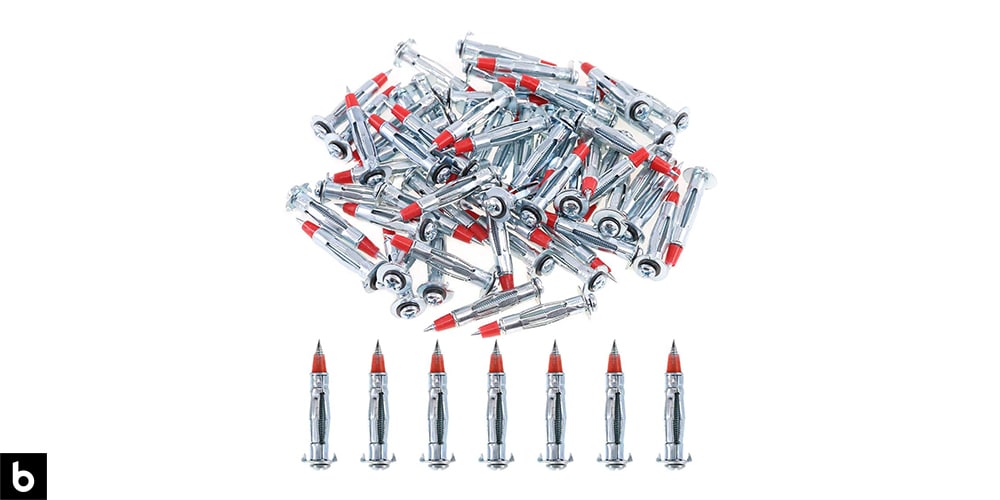
Like the expansion anchors, there’s something called the hollow drive anchors, which uses the expansion anchors’ design. If you’re looking for another good expansion anchor, you’ll want to look at the Glarks Hollow Drive Anchors. With the Glarks Hollow Drive Anchors, you’ll be able to insert the bolt into a small hole in your wall, and as you tighten the bolt up, there’ll be a ‘wing’ design that opens up and grabs the backside of the wall so that you have a firm wall mount. These anchors come with high-quality zinc metal, and they also feature a wide plate on the head of the bolt so that you don’t indent the walls. It also comes with micro-teeth on this plate to prevent the screw from twisting while it’s in the wall.
5. ISpinner Self Drilling Anchors
A Great Self Drilling Wall Anchor.
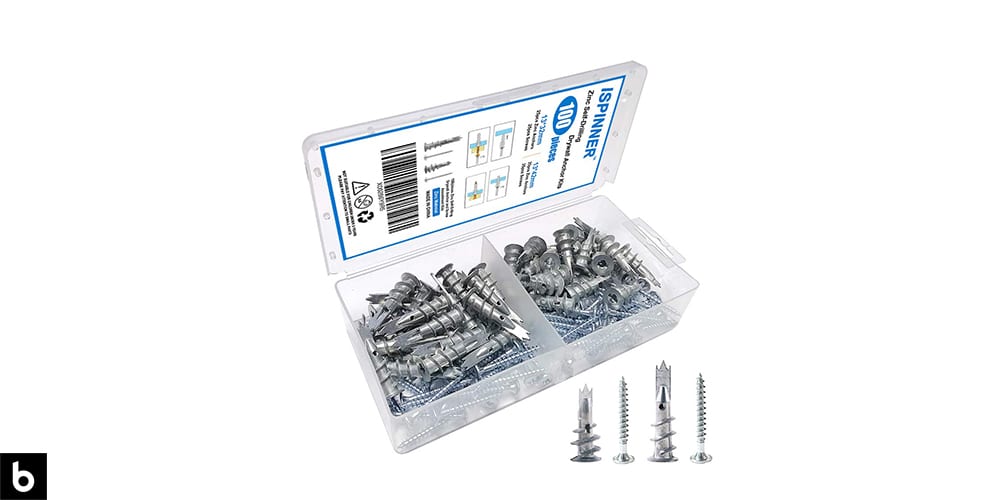
If you opt for the self-drilling drywall anchors, you may want to look at the ISpinner Self Drilling Anchors. These anchors come with a zinc covered metal design, which makes these anchors last for years. With the ISpinner Self Drilling anchors, you’ll get 50 pieces of large anchors and 50 pieces of smaller anchors so that you’ll have enough anchors for any number of items that you need to hang and a variety of weights. These Self Drilling Anchors also come with deep threads that allow you to install the anchors easily, and the deep thread also makes the anchors grab the wall so that they don’t come loose once they’ve been installed in the wall.
Wall Anchor Buying Guide
We want to help you find the right anchors for your project, so we’ve created a buyer’s guide to help you through the process of picking the best drywall anchors. In this section, we’ll look at the benefits of using anchors and show you how to know what type of anchors are perfect for you.
If you’re new to using anchors, you’ll want to stick around and read this buyer’s guide so that you know what features to look for when choosing anchors so you can find the best anchors for your project.
What Are Drywall Anchors?
A drywall anchor or wall anchor is a wall insert that you can use to create a firm wall mount for your photos or wall hangings. Since drywall breaks under pressure, the anchors will place the wall’s weight hanging over a wider surface area.
This will prevent the drywall from breaking since you’re reducing the stress on the drywall by placing the weight over more square inches of drywall.
Benefits of Using Drywall Anchors
The main reason that people use drywall anchors is that it allows them to hang their photos, art and other materials on their walls without the walls breaking down from the weight of the materials that they’re hanging.
With drywall anchors, you’ll be able to hang heavier objects than you typically could without having to worry if there will be damage to your walls. Also, you won’t need to try to find studs with anchors because you can insert the anchors into anywhere that there’s drywall.
One of the benefits of using drywall anchors is because there’s less damage to the drywall once you’ve removed the hanging from your wall. This means that there are fewer walls to repair when you renovate your home or move to another house.
How to Choose the Best Drywall Anchors
In this section, we’re going to look at how you can choose the right anchors for your project. There are several types of anchors and features that you should look at when choosing the best anchors, so you’ll want to read through this section of our buyer’s guide.
Here are the key features to consider when choosing anchors:
1. Choose the Type of Anchor
There are several types of anchors that you can choose when it comes to wall anchors, and they’re all designed to hold various weights. Every type of anchor is designed differently, and they serve different purposes, and even if they look similar, there may be a huge difference in how they perform and the weight they can hold.
The type of drywall anchor you choose will largely depend on what you’re trying to hang, so you’ll want to pay attention to this section of our buyer’s guide to ensure that you find the right type of anchor for your needs.
Here are the different types of wall anchors.
~ Expansion Anchors
The first type of anchor was the expansion anchor, and it’s still the widest spread anchor that you can find. These anchors are designed with sections that expand outwards or ‘bloom’ in every direction so that there’s more surface area to hold the weight of the objects that you’re hanging on your walls.
The expansion anchors are often made from hard plastic or metal materials and are distinct in their design because they have smaller arms that spread out as you begin to tighten your screws into the wall. This creates a wide surface on the back of the drywall, which is ideal for bearing more weight than a regular screw.
With the expansion anchors, you’ll have a strong solution to your problems as long as you buy a high-quality expansion anchor. If you cheap out on the expansion anchors, they’ll begin to break down over time, and they can cause more damage in the long run.
If you use expansion anchors, you’ll want to avoid using them on the roof or ceilings of your home. This is because the expansion anchors aren’t designed to hold a weight that has a downward gravitational pull, and the screws may slip out of the anchor and fall out of the ceiling, causing damage and mess.
~ Threaded Anchors
The threaded anchors are referred to as the ‘self-drilling’ anchors. This is because you won’t need to drill any holes to install the threaded anchors, and they can easily be installed by hand. The threaded drywall anchors have a distinct design and will look like a ‘fat’ screw.
The threaded wall anchors are usually made out of metal or heavy plastic, and they have wide threads down the side that grabs the drywall and hold onto the wall. Once the threaded anchor is in the wall, you’ll drill your screw into the center of the anchor so you can hang your wall hangings.
With the threaded anchors, you’ll have an anchor point that’s as strong as the expansion wall anchors, if not even stronger. However, like the expansion anchors, you won’t want to use the threaded anchors on the roof of your home because they’re not designed for downward gravitational pull.
~ Toggle Anchors
The toggle anchors are another drywall anchor that you can use for hanging stuff from your wall or ceiling. The toggle anchors are often used with longer bolts explicitly designed for the toggle anchor, and you likely won’t be able to use regular screws with the toggle anchors.
The toggle wall anchors are designed to drill a small hole (large enough for the toggle anchor to fit through), then you’ll push the toggle anchor through this hole until the ‘wings’ of the anchor have gone past the bottom of the hole. As you tighten the bolt, the wings on the toggle anchor will begin to open up, and as you place weight on the bottom of the toggle anchor, the wings will be spread wide, and they’ll grab the walls or ceiling.
You’ll have a strong anchor with the toggle anchors that you can use for hanging objects on your walls. Typically, the toggle anchors are used for ceilings, but they can be used for walls as well. However, they’re more difficult to install than other anchors, so you won’t want to choose these anchors unless you’ve had experience using wall anchors in the past or watched some educational videos for using the anchors.
~ Sleeve Anchors
The sleeve anchors are hollow sleeves inserted into the walls, and then you’ll drill your screw into the sleeves’ opening. This will spread the sleeves and create friction in the wall, making it harder for the screws to fall out of the drywall.
These are usually used as a prevention measure to ensure that the screws can be removed from the wall without creating a larger hole in the wall. Also, if you’re careful with the sleeve anchors, you’ll be able to re-use them for multiple wall hangings, and you can usually use the sleeve anchors for hanging up to 3 different objects because they last for a long time.
2. Select the Weight Range
When you’re choosing a wall anchor, you’ll need to consider the object’s weight that you’ll be hanging on your walls. An anchor’s weight range will determine how much weight the anchor can reasonably hold without breaking through the wall or stripping the wall anchor.
If you choose an anchor with a higher weight range, you’ll be able to use them to hang a wider range of objects, including heavier objects. However, if you choose an anchor with a heavier weight range, you’ll likely be paying more money, and these types of anchors will take more time to install in your walls.
The anchors with higher weight ranges are more expensive and take longer to install because they’re designed with different materials than the cheaper anchors. They come with heavy-duty materials, and the technology used to install them is often more complex than the cheaper wall anchors.
3. Pick the Material
As with all building supplies, the materials being used to create the supplies will play a major role in the final product’s quality. When it comes to wall anchors, there is no exception, and the materials used to create the anchors will determine the dependability of the drywall anchors.
Some anchors are built using plastic, and these are the cheaper anchors that don’t cost very much money. However, the plastic anchors also won’t hold as much weight as the metal wall anchors. Some plastic anchors will also break down over time, and the anchor’s interior will strip so that the screw becomes loose.
Other wall anchors are built using metal components, making the anchors more durable, but it also makes them more expensive and harder to use. This is because the metal is stiffer, and it won’t flex through smaller gaps like the plastic anchors. However, the metal anchors can typically hold more weight, and you won’t need to worry about the threads stripping or the screws coming loose if you use a metal anchor.
4. Use the Right Size Screw
When you’re using drywall anchors, you’ll want to ensure that you’re using a screw that properly fits the anchor. One common mistake that’s made with anchors is that people use a screw that’s too large or too small for the anchor.
If the screw is too large for the anchor, you’ll find that the screw eats through the plastic sleeve or binds on the anchor’s metal, and it ruins the anchor. This results in a wall anchor that can support very little weight because you’ve destroyed the anchor with a large screw.
On the other hand, when your screw is too small, the screw won’t grab the anchor, and it will be loose. This means that the screw will wobble in the anchor, and once you place weight on the screw, it’ll fall out of the wall because it’s not screwed tightly. Often the anchors will come with screws that you can use for the wall anchors. If you lose these screws, check the box and find similar size screws to ensure that the anchors are correctly installed.
Summary – Best Wall Anchors 2024
We hope that this product review has helped you find the best wall anchors for your home in 2024. If you’re new to using anchors, you can use our buyer’s guide to help you understand which drywall anchors are the best for you.
